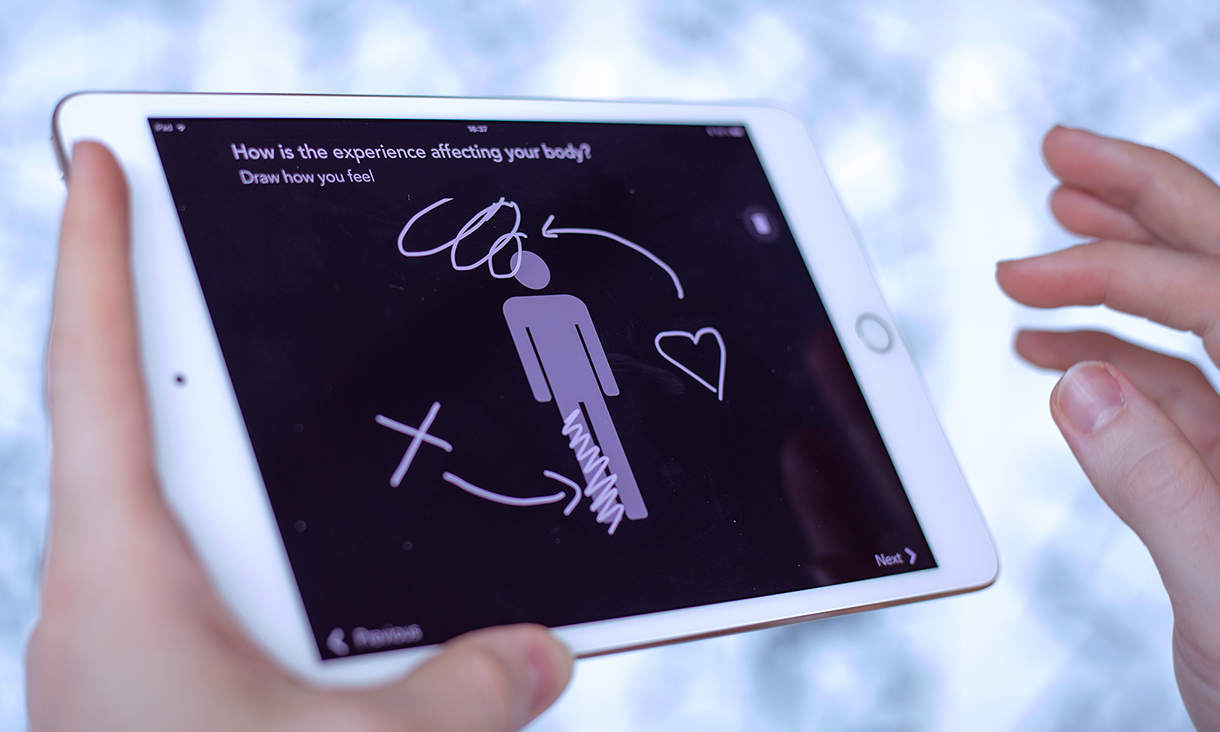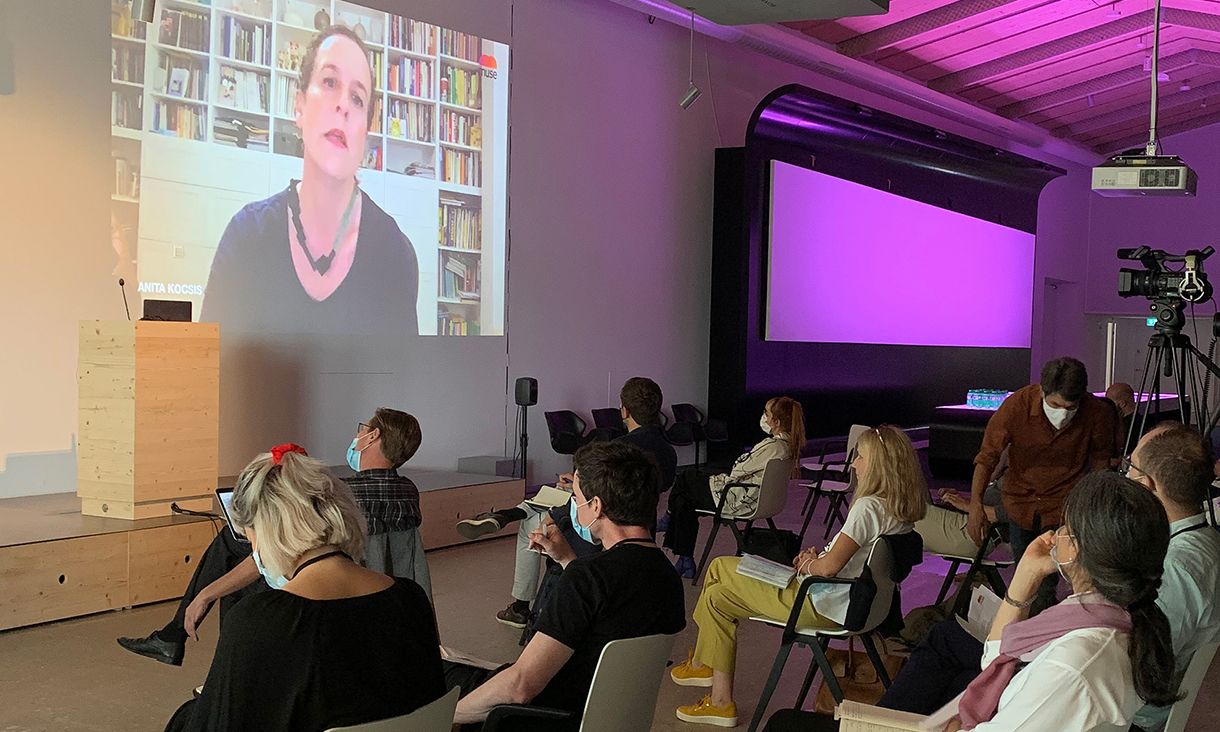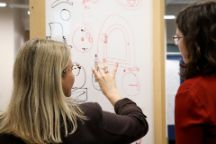New digital tool to improve visitors’ museum experience

Visitors can use the muse platform to draw how they feel about an exhibit at the École polytechnique fédérale de Lausanne (EPFL) Artlab in Switzerland. Credit: Sarah Kenderdine
In summary
- Digital tool ‘muse’ allows for the individualised collection of data around museum visitor experiences
- The platform was co-founded by the Director of Swinburne’s Design Factory Melbourne, Professor Anita Kocsis, and designed by an international research team
- Eight museums in Switzerland are providing industry feedback on the design
Museums come alive through the eyes of visitors. That makes a digital tool like muse invaluable in gathering feedback on visitor experiences.
The creative, forward-thinking design was co-founded by Director of Swinburne’s Design Factory Melbourne, Professor Anita Kocsis, and Professor Sarah Kenderine, who is an expert in digital museology and the director and lead curator the Swiss Federal Institute of Technology Lausanne’s (EPFL) Artlab, and Laboratory for Experimental Museology in Switzerland.

With funding and support from the Migros Pioneer Fund and the Laboratory for Experimental Museology, the international research team launched ‘muse’ in Switzerland in September 2020. Credit: Mary Yacob.
What is muse?
Far from a boring survey, muse features an engaging, interactive design that allows museums to gather feedback on exhibits and other attractions. It allows users to communicate through drawings, voice recordings, interaction with animated graphics or photos they’ve taken. It gathers diverse data on how visitors feel and think.
The platform also aggregates quantitative data, including age, gender, geographic origin and the number of repeat visits, and it is supported in many languages. But it’s the focus on the individual and data analytics of creative expression that makes the platform truly innovative.

Visitors are invited to take a photo of their favourite part of the exhibit or experience in muse – a feature tested at EPFL’s Artlab. Credit: Sarah Kenderdine.
“Through muse, audiences become an active part of the exhibition and assist curators and exhibition designers to explore the value of content presented by cultural organisations,” says Professor Kocsis.
Muse provides real-time feedback on exhibitions and programs, so the experience is more relevant and engaging to visitors. Information collected is based on direct insights through real-time dashboards and data analytics.

A visitor to the Hong Kong Maritime Museum draws her favourite artwork on muse. Credit: Volker Schubert.
The first phase of development was conducted in 2020 in collaboration with eight partner museums in Switzerland: Museum of Design Zurich, the Rietberg Museum in Zurich, House of Electronic Arts Basel (HeK), Geneva Museum of Ethnography (MEG), International Red Cross and Red Crescent Museum in Geneva, the Château de Morges and its museums, the Olympic Museum in Lausanne and EPFL Pavilions.

Live public data from muse was displayed at the World Economic Forum in Tianijin, China. Credit: Allan Jones.
Design innovation at Swinburne
Swinburne’s Professor Kocsis is a pioneer in early-stage design innovation and applied experience research with over fifteen years’ experience in commercial and corporate sectors. She is a leader in design-led innovation, research translation and commercialisation.
Professor Kocsis embraces a co-creative and experimental approach to improving the agency of the human experience in complex, cross-sectoral and interdisciplinary projects. Her work spans science and technology, astrophysics, semi-immersive environments and the ‘co-experience’ of places.
“Experience research through design is an iterative transdisciplinary framework that explores the diffusion of subjective and complex science and technology experiences relevant to broad fields, such as challenges in science communication, health-patient experiences and end use case scenarios,” says Kocsis.
-
Media Enquiries
Related articles
-

- Technology
- Science
- Engineering
Victorian students drive green energy transition through international hydrogen competition
Swinburne’s KIOSC, in collaboration with Horizon Educational and Gippsland Tech School, co-hosted the Hydrogen Grand Prix in Melbourne.Friday 26 July 2024 -

- Technology
- Health
New MedTechVic prototypes to transform everyday lives of people with a disability
Swinburne’s MedTechVic has revealed three new prototypes designed through the joint Health-led Manufacturing Innovation Program, in partnership with the Australian Medtech Manufacturing Centre and Safer Care Victoria
Friday 19 July 2024 -

- Design
Swinburne alum launches zine celebrating Asian Australian art and identity
Swinburne Graphic Design alum Dan Truong founded HOISZN, a zine publication showcasing Asian Australian artists and their work.
Monday 01 July 2024 -

- Design
Swinburne students shine in lighting design collaboration
Swinburne students collaborated with About Space Lighting, resulting in several student-designed lamps being put into production.
Friday 07 June 2024 -

- Business
- Technology
Swinburne’s Luminate Pitch Night 2024 advances innovative ideas for a better world
Swinburne’s 2024 Luminate Pitch Night showcased market-ready ideas from 10 founders
Wednesday 12 June 2024

